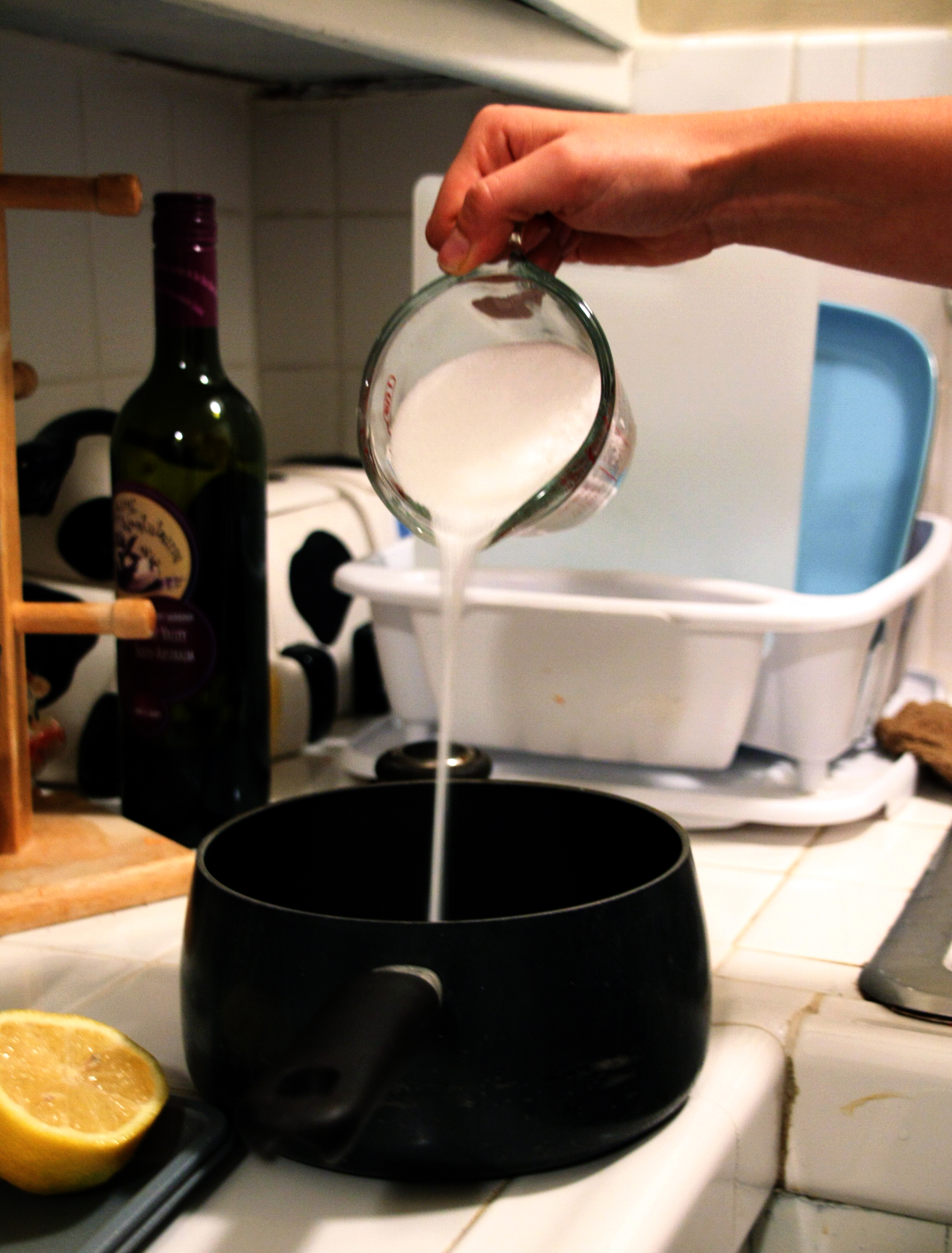Fire in the kitchen: _Baklava the new go-to potluck dessert_

Baklava
Ingredients:
1 package phyllo (fillo) dough ($3.99 at Ralph’s)
1/2 lb unsalted butter, melted ($2.99 at Ralph’s)
1/8 c vegetable oil
Filling:
1/2 lb walnuts or almonds, finely chopped
2 1/2 tb sugar
1/2 ts cinnamon
Syrup:
1 cinnamon stick ($2.79 at Ralph’s)
1 1/2 c water
1 1/2 c sugar
2 ts lemon juice
Preparation:
1. Let phyllo dough unfreeze overnight in refrigerator and take out about one hour before using. Once you open the package, cover phyllo not being used with a barely damp towel.
2. Preheat oven to 350 degrees.
Directions:
1. Mix walnuts (or almonds), sugar and cinnamon together for the filling.
2. Combine syrup ingredients in a sauce pan and cook until sugar dissolves and mixture turns syrupy.
3. Set syrup aside to cool. Remove cinnamon stick before using.
4. Mix butter and oil.
5. Place one sheet of phyllo dough on a cookie sheet, keeping the narrow end facing toward you. Brush with butter/oil mixture.
6. Place second sheet on top and repeat.
7. Place 2-3 tablespoons of the filling along the end nearest you.
8. Roll into a cigar-like cylinder. Place roll on cookie sheet, brush with butter and sprinkle with water.
9. Repeat with remaining filling and phyllo dough.
10. Bake in the oven for about 25 minutes or until golden brown.
11. Pour cool syrup over the roll right after taking out of the oven and cut the roll into 1-inch pieces.
12. Let cool and serve. Do not refrigerate.
By Maryia Krivoruchko
Dec. 2, 2010 3:02 a.m.

Fourth-year psychology and French student Dalia Cohen takes a bite out of Krivoruchko’s twist on Cohen’s Greek baklava.

Baklava is made from phyllo dough, sugar and cinnamon and baked in rolls.

Much like the adage “all that glitters is not gold,” not all that tastes like honey is actually honey.
Baklava, something I’ve always associated with the bee product, is a layered pastry made of nuts and thin crispy dough and covered in sugary syrup.
But much to my surprise, honey was nowhere in the recipe submitted for this week’s column. It seemed like a mistake.
Like other Mediterranean and Middle Eastern recipes readers have sent in this quarter, baklava’s origin is disputed among multiple nations. It likely originated in the Ottoman Empire, which controlled the majority of the region for hundreds of years, and then the dessert spread to Turkey, Greece, Pakistan and everywhere in between.
According to fourth-year psychology and French student Dalia Cohen, who contributed the recipe, this particular baklava is of Greek origin, as contrasted with the thick, pistachio-based baklava from Iran. The recipe is her mom’s, who was born in Salonika, Greece.
Since the sweet treat’s debut at her friend’s birthday dinner while studying abroad in Italy, baklava has been Cohen’s go-to dessert to prepare for parties. I can see why ““ it tasted so much more complex than its preparation entailed.
The steps were as follows: Butter a sheet of dough, put another sheet on, butter it, put on some filling, roll, butter again, bake and douse with simple syrup. Paula Deen would have been so proud.
Though easy, it took awhile to make. I spent almost three hours with my phyllo dough on Monday night. I was almost sore from standing for so long, and I distinctly remember asking my friend if housewives really live like this (slaving three hours for a dessert).
I produced an enormous amount of baklava at the end, but next time I’ll invite some friends over, and we can make the dough-rolling a fun dinnertime activity. Cohen put her roommates to work the last time she made baklava too.
Phyllo dough is as thin as tissue paper, and much like any other piece of tissue that I’ve ever handled, I ripped the first piece to bits immediately. Shredded at my first touch, the phyllo proved once more that gentleness and grace are not two of my dominant traits.
A few baklava cylinders on my cookie sheet later, I got the hang of the dough, and the process went much faster. While I worried that the baklava would stick to the sheet, the butter brushed on top allowed for easy removal.
As soon as the rolls turn golden brown, pour the syrup on top. My syrup did not turn out to be very thick, but in retrospect this worked well ““ the baklava did not need any added richness. Each little piece is addictive and filling. The taste was surprising. It’s like the syrup was honey-based, but it wasn’t at all.
I substituted almonds for walnuts in the original recipe (because I forgot to buy the walnuts). Cohen said that there is something really different about the baklava I made and chalked it up to the nut difference. She said that the beauty of baklava is that every time you make it, it turns out differently.
Whatever it was, the recipe made me a believer. It’s going to be my go-to potluck dessert too.
E-mail Krivoruchko recipes for next quarter at [email protected]. She is willing to cook something outside of the Mediterranean and Middle Eastern regions.


